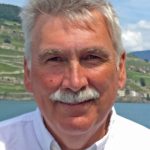Purity of thought: Mrs. Eddy’s insistence on purity of thought and
morals seems to come more definitely to me lately and it runs through the pages
of this book (Mary Baker Eddy: Christian
Healer).
[Ed. The setting is
around 1870 when Mary taught her first class (p. 87). At that time, Science and Health with Key to the
Scriptures had not yet been written and her students were aided by several
papers written by their teacher as well as her “teaching manuscript” (p. 88)
called “The Science of Man”
(ibid). In a revision of that document she wrote:]
A
student of Moral Science, and this is the Science of man, must be a pure and
undefiled Christian, in order to make the most rapid progress in healing… (p.
89).
Process of teaching: On the previous page, there is a quote from a
letter Mrs. Eddy wrote to her student Mr. S. P. Bancroft in reply to his
question about “how [one] should metaphysically view the process of teaching”
(p. 88):
When
I teach science it is not woman that addresses man, it is the principle and
soul bringing out its idea. …My scholars may learn from me what they could not
learn from the same words if uttered by another with less wisdom than even my
“grain of mustard seed,” hence, it is not the words, but the amount of soul
that comes forth to destroy error. (ibid).
I had an “Aha!” moment. Aha!
That is the reason behind her prohibiting the taking of notes in her classes.
Genesis: She wrote 600 pages of notes on the book of Genesis
between 1867 and 1868! (see page 128.)
Jesus’ example: And here is a hint on being a follower of Jesus,
“the higher grew the affection of Jesus, the grander grew his demonstration.” (See
page 137.)
Index to SH: It had never sunk in for me that the Reverend Wiggin
prepared the first index to Science and Health. (See page 139.)
Easter 1888: I don’t suppose there has ever been a service similar
to the one held at Easter time in 1888. “The service that first of April was
largely a concert by the Sunday School children. No fewer than eighteen hymns
and anthems … Half way through, twelve young ladies each answered a question,
responding with a passage from Science and Health with Key to the Scriptures”
(pages 145, 146).
Demonstration vs repetition: Readers of my contributions to the
blog may recall that I have long been a fan of Robert Peel’s Mary Baker
Eddy: The Years of Authority. There is one gem which I have perhaps not
really come to terms with. Here it is on page 213 of Peel’s book:
Five times ten are fifty. This is science. Echo answers: “Five times ten
are fifty. This is science.” The first statement is true and the latter is
untrue. Why? Because one…demonstrates Science...the other repeats Science….
I was reminded of this when I came to page 157
of our book, where in reference to the point that some of her students were
using written formulas in their healing work, she wrote to one student:
Tell every one whom you know of doing this, that it is as far from
scientific as it would be to give or order drugs. The written direction, beyond
a general scientific rule for practice which is already given in Science and Health,
confines the practice to mortal mind and is nothing more or less than human
directions, mind cure, and will produce the effect only of animal magnetism.
I may be imagining a
correlation. I would love to hear from another blogger on this one.
Poetic
purpose: On page 154 I was enlightened about Mrs.
Eddy's poem/hymn Love:
Love was the only
way Mrs. Eddy knew to respond to hate or settle disagreements. A number of
years after this [Ed. Probably a number of years after 1888], she would write a
poem entitled "Love." It is a beautiful lesson on healing
disputes. In it she points out, "The arrow that doth wound the
dove / Darts not from those who watch and love," and she ends with
...Love
alone is Life;
And
life most sweet, as heart to heart
Speaks
kindly when we meet and part.
I
had never understood that the poem had been written with settling disputes in
mind. I guess each of those hymn/poems was written for a healing purpose needed
at the time.
Joyce
Voysey



